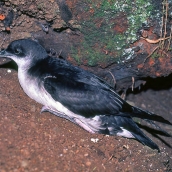Manx Shearwater (Puffinus puffinus)
This pelagic seabird measures 30-35 cm in length, has a wingspan of 71-83 cm and is distinguished by a sharply contrasting black back and white belly. The dark tones of the head extend to below the eye, a feature shared with the Cape Verde little shearwater (Puffinus boydi), but not the Barolo shearwater. It also has the characteristic tubular extended nostrils (through which excess sea salt is eliminated) of species of the order Procellariiformes, as well as webbed feet. When approaching breeding colonies, this shearwater lets out a very peculiar, cackling call, whose sound has led to the onomatopoeically coined vernacular names of estapagao or apagao, in the Canaries and patagarro in Madeira. This species hails from the North Atlantic and is particularly common in the British Isles. In Macaronesia it breeds in the Azores (Flores and Corvo, with isolated breeding records from Santa Maria and São Miguel), Madeira and the Canaries (La Palma and Tenerife, and possibly La Gomera). It is observed relatively often in the open sea near Madeira, the Savage Islands, the Canaries, and to a lesser extent, Cape Verde, especially in late summer and early autumn. It mainly feeds on fish and cephalopods, but scant information is available for Macaronesia. Despite being a marine bird, it breeds on hillsides and ravines with laurisilva laurel or evergreen forests and soft soils, digging out its own burrow or hollow, where it lays a single egg. Colonies are often located several kilometres inland, and in some cases at altitudes above 1,200 m, as in Madeira. In the Azores, however, there is an isolated report of an attempt to breed on a rocky islet. The breeding season, which extends from February to September, varies between island groups and occurs later in the Azores than in Madeira or the Canaries. The shearwaters abandon their breeding areas from August-September and make their way to South America. The first specimens return in January, and from February on their cackling calls are heard in the colonies. Populations are dwindling in this part of the Atlantic, where the species is bordering on extinction in the Canaries and becoming increasingly rare in Madeira and the Azores. In the late 1980s and early 1990s, around 20 pairs were estimated for Tenerife and fewer than 200 for La Palma, but recent studies point to far lower numbers. In Madeira, there are around 2,500-1,000 specimens and in the Azores the figures stand at roughly 115-240 pairs. This situation has resulted from the negative impact of various threats, including the capture of specimens for human consumption (in the past), predation by cats and rats, urban glare in built-up areas (particularly affecting juveniles), marine pollution and collision with overhead cables located near breeding colonies.













